Environmental Management
OUTPUT
Changes of Annual Emission of Greenhouse Gas [Only for business establishments in Japan]
Greenhouse Gases
Emissions of greenhouse gases in 2009 across the DOWA group was 1,187,000 t (1,166,000 t in Japan and 22,000 t outside Japan), which was a decrease of about 6% compared to last year domestically. In 2009 as power consumption at Akita Zinc decreased, CO2 derived from power generation also decreased.
Among the DOWA group, DOWA Eco-System and DOWA Metals and Mining mainly contribute to emission of greenhouse gases. As for the source of emission, power generation contributes the most, followed by recycled materials from wastes.
Thermal treatment of wastes from other companies accounts for a great percentage of CO2 emission in our environmental business. The 2009 annual CO2 emission derived from wastes that were received from other companies by our business establishments in Japan amounted to 420,000 t. It is difficult to reduce such emission on the receiving side. Therefore, we try to promote effective use of heat from combuted wastes such as power generation and utilization of steam.
CO2 is calculated by multiplying purchased electricity, purchased fuel and amount of accepted wastes by emission factor set forth in the Act on Promotion of Global Warming Countermeasures. However, CO2 emission derived from wastes does not always correspond to the values submitted to administration authorities, as part of the prerequisites used in the method for this report differ from that for the reports to administration authorities.
CO2 emission from business establishments outside Japan does not include CO2 emission derived from combusted wastes. As segregation of wastes differs between Japan and other countries, it is difficult to set a proper emission factor to such emission.
< Derived from power generation + fuel >
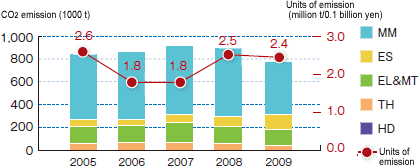
< Derived from wastes >
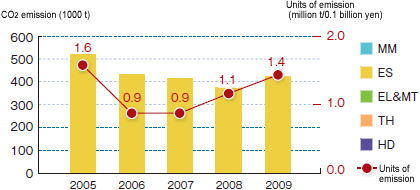
< Derived from power generation + fuel + wastes >
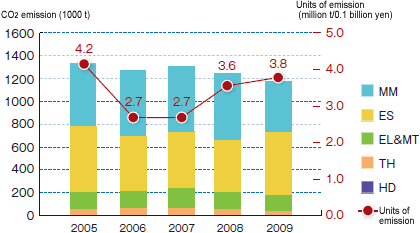
Other emissions
Our amount of GHG emissions in 2009 amounted to 25,200 kg CO2. This was a result of the hydrofluorocarbon used in our business activities (4kg of HFC-134a and 20 kg of HFC-125). Although this accounted for only 0.0004% of the entire GHG emission of the DOWA group, we further endeavor to reduce the amount to prevent global warming.
Our 2009 Efforts towards Prevention of Global Warming
| Energy-saving activities | Introduction of the motor control by inverter Reduction of in-plant excessive lighting Utilization of power generation at night Reduction of power consumption by optimizing operational conditions of equipment Replacement of in-plant lighting equipment Reduction of lines through integration of lines Reduction of air flow into incinerators Upgrading of transformers |
| Introduction of renewable energy | Solar power generation |
| Switching to fuel that produces less CO2 emission | Switching from gasoline to natural gas Use of pellet stoves in offices Utilization of steam from adjacent companies Switching from heavy oil to LPG |
| Activities related to transportation | Switching from transportation by trucks to railways More efficient collection and resale |
| Other efforts around our workplaces | Turning lights off at break times Encouraging to turning lights off |
Wastes
Wastes generated in 2009 were about 367,000 t (358,000 t in Japan and 9,000 t outside Japan), an increase of 10% compared to last year. This is due to significant increase of wastes processing at Eco-System Chiba where a new furnace was installed.
Wastes from business establishments in Japan consisted of 92% of industrial wastes and 8% of general wastes (business-related). Industrial wastes mainly consisted of burnt residues (34%), sludge (25%), slag (22%) and ash dust (12%).
< Changes of Annual Production of Wastes >
[Only for business establishments in Japan]
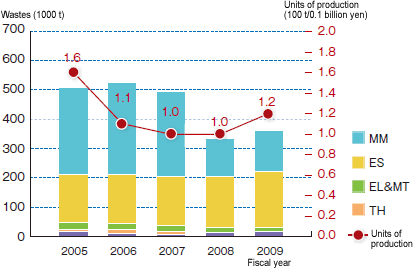
<Changes of Annual Recycling Volume>
[Only for business establishments in Japan]
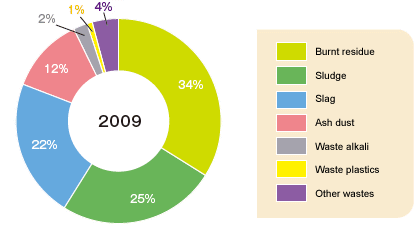
Recycling
In 2009, volume of recycling amounted to 433,000 t (423,000 t in Japan and 11 t outside Japan), a decrease by about 21% in Japan compared to last year. This is mainly due to the decreased amount of soil disposed.
Recycling in business establishments in Japan consisted of recycling of materials (84%) and thermal recycling (16%). The materials recycled were mainly soil (59%), gypsum (21%) and metals (10%). Thermal recycling consisted of shredded dust (38%) and waste plastics (12%).
<Details of Wastes>
[Only for business establishments in Japan]
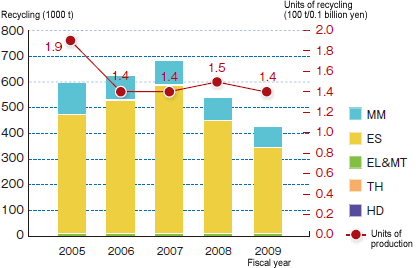
<Details of Recycling of Materials>
[Only for business establishments in Japan]
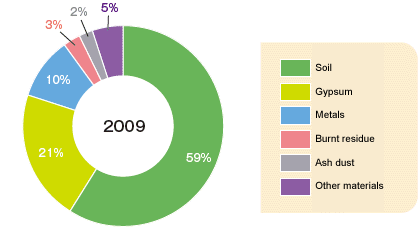
Our efforts to reduce packaging materials in 2009
- Reduction of package materials by package innovations such as reducing the number of individual packages using larger containers.
- Promotion of re-use of containers and packaging materials by using adaptable containers and returnable containers.
- Encouragement to take back or collect the containers and by our vendors.
Prevention of Air Pollution
Exhaust emissions in 2009 was 7.723 million m3 (7.470 million m3 in Japan and 253 million m3 outside Japan), which remained almost unchanged from last year in Japan.
Emission of nitrogen oxide in Japan also remained unchanged from last year, while sulfur oxide decreased 41% compared to last year. A new sulfuric acid plant (new operation of the flue gas desulfurization equipment plant) at Akita Zinc contributed to the decrease.
<Changes of Annual Emission>
[Only for business establishments in Japan]
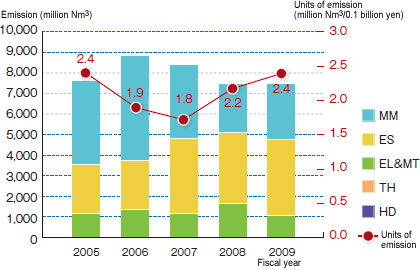
<Changes of Emission per Substance>
[Only for business establishments in Japan]
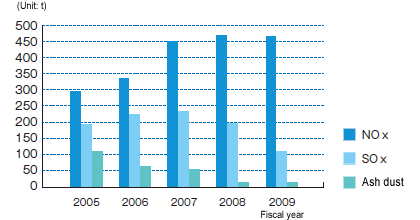
Prevention of Water Pollution
Quantity of waste water discharge in 2009 was about 103 million m3 (102 million m3 in Japan and 0.3 million m3 outside Japan). In 2009 in connection with the decrease of usage of service water at Akita Zinc, the quantity of wastewater discharge decreased, resulting in the decrease of discharge of the entire DOWA group.
Emission of BOD (biochemical oxygen demand) and COD (chemical oxygen demand) in Japan decreased by 16% and 24% respectively compared to last year.
<Changes of Annual Waste Water Discharge>
[Only for business establishments in Japan]
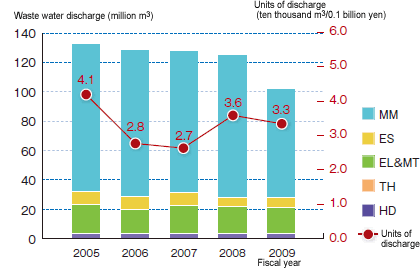
<Changes of emission per substance>
[Only for business establishments in Japan]
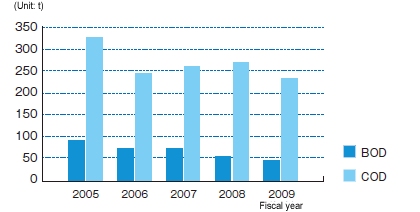
Control of Chemical Substances (those targeted for PRTR)
We endeavor to reduce disposal of substances targeted by the PRTR (Pollutant Release and Transfer Register) law in each of our plants, based on the law concerning assessing the discharged amount of special chemical substances and promotion of improving their management.
Unit: t
| Cabinet order No. | Name of Class 1 chemical substances | Discharged amount | Transferred amount | ||||
|---|---|---|---|---|---|---|---|
| Atmosphere | Water area | Soil | Landfill within our own property | Sewage system | Outside of each business establishment | ||
| 1 | Water-soluble compounds of zinc | - | 6 | - | - | - | - |
| 25 | Antimony and its compounds | 0.049 | 0.133 | - | 113 | - | - |
| 40 | Ethyl benzene | 0.029 | - | - | - | - | 2.9 |
| 43 | Ethylene glycol | - | 0.0784 | - | - | - | 5.3 |
| 60 | Cadmium and its compounds | 0.03 | 0.055 | - | 43 | - | - |
| 63 | Xylene | 0.032 | - | - | - | - | 3.1 |
| 64 | Silver and its water-soluble compounds | 0.026 | 0.0004 | - | 5 | - | 0.2 |
| 68 | Chrome and trivalent chrome compounds | - | - | - | 7 | - | 1 |
| 89 | Toluene | 3 | - | - | - | - | - |
| 100 | Cobalt | - | - | - | - | - | 3 |
| 108 | Inorganic cyanogens compounds | - | - | - | - | - | 0.01 |
| 175 | Mercury and its compounds | - | - | - | 0.154 | - | - |
| 178 | Selenium and its compounds | 0.024 | 0.08 | - | 9 | - | - |
| 198 | 1.1.5.7- tetraazatricyclo | - | 0.082 | - | - | - | 1,090 |
| 207 | Water-soluble copper salt | - | 1 | - | - | - | 7 |
| 230 | Lead and its compounds | 1 | 0.0175 | - | 1.678 | - | 56 |
| 231 | Nickel | - | 0.015 | - | - | - | 70 |
| 232 | Nickel compounds | - | - | - | - | - | 0.02 |
| 243 | Barium compounds | - | - | - | - | - | 15 |
| 252 | Arsenic and its inorganic compounds | 0.073 | 0.0161 | - | 317 | - | 3 |
| 253 | Hydrazine | - | - | - | - | - | 2 |
| 283 | Hydrogen fluoride and its water-soluble salts | 1 | 15 | - | - | - | - |
| 304 | Boron and its compounds | - | 6 | - | - | - | 6 |
| 311 | Manganese and its compounds | - | 7 | - | - | - | 855 |
| Unit: g-TEQ | |||||||
| 179 | Dioxin | 0.28 | 0.004 | - | - | - | 11.62 |
Our Main Efforts towards Proper Control and Reduction of the Substances Targeted for the PRTR
To reduce usage of chemical substances through modification of product designs and specifications